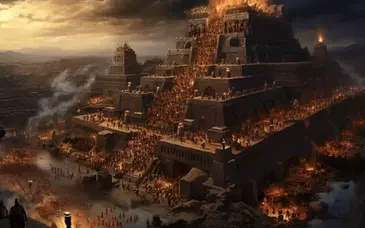Australia And The Islands Of The Sea, Part Three
Author: Larkin, Dunton
Chapter VII. Tasmania.
Tasmania lies a hundred and thirty miles south of Australia, from which
it is separated by Bass Strait. It was known formerly as Van Diemen's Land,
and contains an area of more than twenty-six thousand square miles. The coast
line is considerably broken, especially on the south. The surface of the
country is mountainous, varied by deep, narrow valleys, extensive undulating
tracts of country, and open plains of limited extent. Ben Lomond and Cradle
Mount are each more than five thousand feet high, and there are several other
peaks exceeding four thousand feet. Nestled among the central mountains, at
an average height of three thousand feet, are numerous small lakes; these feed
the greater part of the rivers draining the southeast slope.
On approaching the island from the north, the first object that attracts
the attention is a lighthouse one hundred and forty feet high. It marks the
mouth of the Tamar River. The tide in this river is characterized by a
remarkable rise and fall, the difference between high and low tide being
fourteen feet. Here and there along its shores isolated houses dot the
country. These are not cabins, but neat, permanent structures, near which are
large barns and other appropriate buildings. These barns signify that the
domestic animals have need of protection during the winter, which is not the
case in Australia.
Forty miles from the mouth of the river is Launceston. Its tall smoking
chimneys proclaim the fact that the people are busy smelting ores dug from the
neighboring hills and valleys. This town is at the head of navigation on the
Tamar River, in a beautiful valley surrounded by hills. It has a population of
seventeen thousand. Like Melbourne, its streets are broad and regularly laid
out. A good supply of water is brought from St. Patrick's River, fifteen
miles away. Its many substantial buildings of brick and stone impart an air
of unusual prosperity to the place.
A mountain range, from two to five thousand feet in height, occupies the
central part of the island, while its plains and valleys give pasturage to
nearly two million sheep, besides large numbers of cattle. The wool produced
is of an excellent quality, and always commands the best price. In the
mountain ranges and near them, gold, silver, tin, copper, and coal abound; so
that the land teems with mineral wealth, as yet undeveloped.
One hundred and fifty miles from Launceston is the famous Mount Bischoff
tin mine. It may be reached from the city either by land or water. The
quartz, or tin-bearing rock, may be said to form the entire hill to the height
of three hundred feet. Several shafts have been sunk to the depth of a
hundred feet, showing that the metallic deposit reaches that depth, and is
practically inexhaustible. The tin is shipped direct to England in the form
of "pigs," the demand from that country absorbing the entire product of the
mine.
One hundred and fifty miles south of Launceston is Hobart, the capital of
Tasmania. The two places are connected by a narrow gauge railroad owned and
operated by a private company. The city occupies a fine position, twenty
miles from the sea, at the head of a sheltered estuary called Sullivan's Cove.
On the other three sides it is surrounded by hills and mountains, the loftiest
being Mount Wellington. The city is square, and is built upon a succession of
low hills. Its broad streets intersect one another at right angles. They are
lined with well-stocked stores, and among them are several elegant bookstores
which would do credit to any American or European city, their shelves
containing a full assortment of both modern and classical literature.
Its public buildings and many of its private residences are constructed
of light freestone, which not only gives an imposing aspect to its
thoroughfares, but produces a pleasing effect whether seen in sunshine or
shadow. The population numbers thirty thousand. Though the prospect is so
pleasing, Hobart has not yet outlived the curse of the penal institutions
which characterized its early history. Fifty years ago the British government
was spending five thousand dollars a day in support of jails and military
barracks. The last convict ship from England discharged her cargo in 1851.
Since then the system, with all its incidental barbarities, has gradually
disappeared.
The Botanical Garden covers an area of over twenty acres. It is filled
with ornamental trees, flowers, and fruit trees, from a every part of the
world. Even in the winter, which, for the climate, is mild and wonderfully
equable, sweet-scented shrubs and flowers render the dewy morning air
delightfully fragrant.
In some respects the street scenes are novel. The typical miner, with
his canvas bag, his pick, and shovel on his shoulder, seems omnipresent. The
chimney sweep, whom we know only as belonging to olden times, is seen here,
with blackened face and soiled hands, pursuing his vocation. Market men,
galloping on wiry little horses, deliver their goods to customers, in baskets
which they bear on their arms. Women, with scores of slaughtered rabbits, cry
them for sale at sixpence for two, and realize a bounty, besides, for killing
them, as they are counted as pests.
The fish market is also an interesting place. The inhabitants of the sea
differ very much from those with which we are most familiar. The lobsters
have a corrugated shell exceedingly hard, and lack the claws which are so
conspicuous a part of ours. The best of their oysters are of a very inferior
grade.
There are about thirty species of mammals in Tasmania, of which one half
are marsupials. Among the latter are the kangaroo, wallaby, opossum, and
wombat. The Tasmanian devil is also a marsupial, and is peculiar to Tasmania.
It is sometimes very destructive to sheep. The skin of the kangaroo is much
prized for leather, and opossum fur sells well. The majority of the birds of
the island are identical with those of Australia. The black swan is now seldom
seen in the settled districts. There are thirteen species of snakes, most of
which are venomous, but accidents from their bite seldom occur.
About twenty miles from Hobart is a fine forest of gum trees similar to
those abounding in Australia. The people say that they can show trees larger
than any in Victoria. One which had fallen was of extraordinary size, being
three hundred and thirty feet in length, and its trunk having a circumference
of seventy-one feet. In these forests, local steam sawmills are constantly at
work preparing lumber of various dimensions for market.
The aborigines of Tasmania resembled those of Australia only in color.
They were well formed and athletic and had flat noses, curly hair, bright
eyes, and elaborately tattooed bodies. They were low in the scale of
barbarism and were addicted to cannibalism. They are now utterly extinct.

